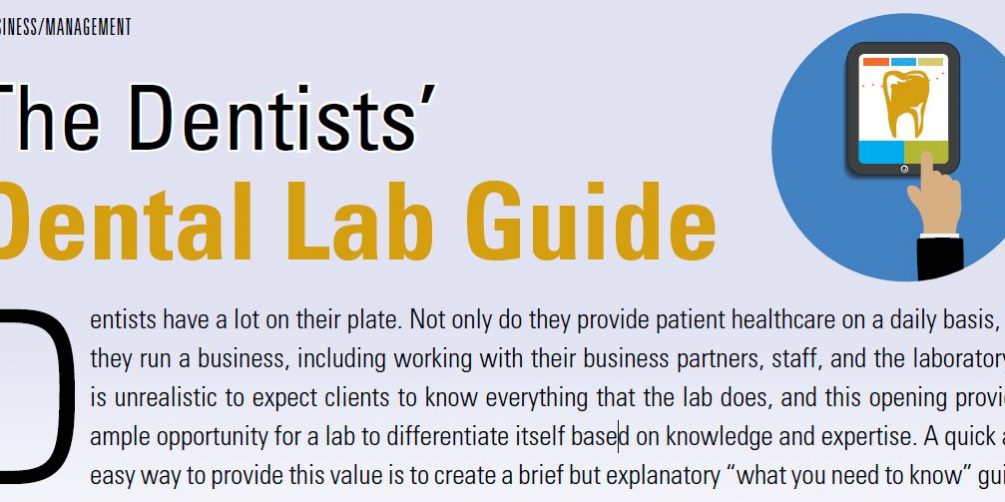The Dentists’ Dental Lab Guide
Dentists have a lot on their plate. Not only do they provide patient healthcare on a daily basis, but they run a business, including working with their business partners, staff, and the laboratory. It is unrealistic to expect clients to know everything that the lab does, which provides ample opportunity for a lab to differentiate itself based on knowledge and expertise. A quick and easy way to provide this value is to create a brief but explanatory “what you need to know” guide. A checklist is a straightforward and non-confrontational way to detail what dentists need to do to make their workflow more efficient, which directly results in better patient care. In this day of extreme technological and material advances, and especially considering newly graduated dentists with limited lab knowledge, it is the responsibility of the lab to help guide their clients. Taking the time upfront to work through the details results in a win-win scenario for the lab and the dentist. Jerry Ragle, CDT, Ragle Dental Laboratory, Champaign, Ill., provides some examples of areas to highlight.
-Lab RX
Whether the prescription is online or paper, it needs to be filled out completely. Do not write ‘Please Call” unless absolutely necessary. An RX is the lab’s guide and if it isn’t complete it will prompt a phone call which takes up valuable doctor/staff time. Too much information is always better than not enough.
-RX Notes
Be thorough from the start and address any questions, requests, design info, etc. If a case is received and a few days later modified, the case could already be out of design causing the lab to backtrack or start over.
-Scanner RX
Scanners have a built in electronic RX but the restorative choices are generic and typically do not correspond with a lab’s RX. Ask the lab if they have a cheat sheet. We have cheat sheets available on our website that outlines the differences for each system.
-Time schedule (delivery date)
When an office schedules a case, make sure the person scheduling adheres to the lab’s working days schedule so not to short the lab which in turn will either prompt a call or add additional cost.
–What is typically overlooked
Restorative shade and especially stump shades. Today, the majority of restorative work is all-ceramic. The underlying color of the tooth can and will influence the final shade, therefore, the underlying color called a stump shade is equally important. Restoration material is also overlooked. Laboratories offer various types of material options. Become familiar with those materials. As an example, see https://ragledental.com/products/
-Signature
Last but not least sign the RX whether it is by hand, a stamp or electronic. It is a requirement of The Dental Practice Act.
“If proper communication and diagnostics have been done prior to the start of a case then little communication during the process needs to take place,” said Ragle.








That’s a really wonderful list of dental lab guides. Without a dental lab, it is not possible to perform various experiments. So, if there is a good dental lab, the dentists get a lot of help. Thank you very much for sharing this! This will surely update a lot of people about dental labs.
Dental crowns Malden
I just came across this site and found this informative blog about dentistry. Thanks for sharing.
Dentist Malden MA
I just came across this site and found this informative blog about dentistry. Thanks for sharing.
Dentist Malden MA
Thanks for sharing.
This is very helpful! Will definitely keep this in mind for our dental lab. Keep up the greant content and thank you for sharing.
Great guide! Thank you for sharing your knowledge. This is helpful for new dental clinics and labs.
Thank you for this informative post! Dental labs are an important part of the dental industry, and they play a vital role in the production of dental prosthetics and appliances. As such, it is important for dentists to have a good understanding of how dental labs operate and what they can do to help ensure that their patients receive the best possible care.